Abstract
In this work, we present a new Bishop frame for the conjugate curve of a curve in the 3-dimensional Lie group . With the help of this frame, we derive a parametric representation for a sweeping surface and show that the parametric curves on this surface are curvature lines. We then examine the local singularities and convexity of this sweeping surface and establish the sufficient and necessary conditions for it to be a developable ruled surface. Additionally, we provide detailed explanations and examples of its applications.
MSC:
53A04; 53A05; 53A17
1. Introduction
The mutual appearances of algebra and geometry, which are two considerable topics of mathematics, are composed Lie groups in two shapes: as a Lie group, and as a differentiable manifold. Thus, the algebraic and geometric structure of Lie groups must be consistent with a specific technique. The treatise of Lie groups is great to the mutual new track to geometry. Therefore, there are considerable results on curves and surfaces in the 3-dimensional Lie group [1,2,3,4,5,6,7,8].
In the Euclidean 3-space, a sweeping surface is a surface that is traced from a section curve positioned over a path, which acts as the spine curve. Sweeping is an essential and famous tool that is utilized for geometric modeling. This idea depends on taking several geometrical topics (such as generators) that are moved along the spine curve (trajectory) in space. This evolution includes the movement in space with the deformation of intrinsic properties resulting in the sweep object. The type of the sweep objects is based on choosing both generators and trajectories. Therefore, sweeping the curve through another curve creates the sweeping surface. Many familiar names of sweeping surfaces are known such as tubular surface, pipe surface, string, as well as canal surface [9,10,11,12,13,14,15]. A considerable fact about sweeping surfaces is that they can be developable ruled surfaces [15]. Developable ruled surfaces are vastly applied in the industrial manufacturing of some non-expandable materials, such as leather, cloth, metal plate, etc. There can also be seen in modern automotive design, aircraft wing design and upper design. There are three types of developable ruled surfaces: cylinders, cones and tangent surfaces [15,16,17,18,19,20]. However, to the authors’ knowledge, there is no work devoted to discussing the conceptions of sweeping surfaces with conjugate curve of a curve in the 3-dimensional Lie group .
In this work, the geometry and kinematics of a sweeping surface with a conjugate curve of a curve is offered based on Bishop frame in 3-dimensional Lie group . The relations among the curvature lines and singularities of this surface are expressed in simple form with geometrical reasoning and demonstration. Then, we derived the sufficient and necessary conditions for the the sweeping surfaces to be a developable ruled surfaces. We also investigated the uniqueness and the singularities of such developable surfaces. Meanwhile, some examples are offered and explained in detail.
Hopefully, these results will drive a connection with the similarities among the theory of the sweeping surfaces in Euclidean 3-space and, with that, in the 3-dimensional Lie group.
2. Preliminaries
In this section, we present important concepts that we will employ in this paper (see [1,2,3,4,5,6,7,8,9,10]). Let be a Lie group with a bi-invariant metric , and ∇ be the Levi-Civita connection of . If indicates the Lie algebra of , then is isomorphic to where e is the identity (the neutral) element of . For any vector fields x, y, , we obtain:
and
Let be an arc-length smooth curve (unit speed curve), and {, } be an orthonormal basis of . In this case, any two vector fields x and y can be written as , and , where , : are smooth functions. The Lie bracket of x and y is
and the directional derivative of x on the curve is as follows
where , and , where . Note that if x is the left-invariant vector field to the curve, then .
Let {, , , , } denote the Serret–Frenet apparatus of the curve in ; then it is easy to see that (see for details [1,2,3,4,5,6,7]).
Definition 1.
There exists a differentiable function named Lie torsion realized by:
or
Proposition 1.
Consider to be an arc-length parametrized curve in . Then the following holds:
Remark 1.
Let be a 3-dimensional Lie group with a bi-invariant metric. Then the following holds:
(1) If is the special orthogonal group (3), then ;
(2) If is the special unitary group (2), then ;
(3) If is a commutative (Abelian) group, then .
Lemma 1.
For the unit speed curve , there is a unit speed conjugate mate curve and the pair , is named the conjugate pair [21].
Let , , be the Serret–Frenet of , then [21]:
The Serret–Frenet equations are as follows:
where is the Darboux vector.
Definition 2.
A movable frame , along the space curve, is named a rotation minimizing frame (RMF) or Bishop frame, with respect to ( 3) if its Darboux vector ω fulfills .
In view of Definition 2, the set , , is RMF with respect to , but not with respect to the tangent and the binormal . However, one can readily gain such an RMF from it. New normal plane vectors (,) are recognized through a rotation of (,) via
with a certain angle . Here, the set , is an RMF or conjugate Bishop frame (CBF). Then, we have
where is the Darboux vector. One can show that
3. Sweeping Surfaces with Conjugate Bishop Frame
The conception of a sweeping surface is realized kinematically by a planar curve, movable through space such that the activity of any point on the surface is constantly orthogonal to the plane [8]. By utilizing the conjugate Bishop frame, the sweeping surface family that passes through is parametrized by
where is the planar profile (cross-section) curve specified by , the symbol ‘T’ appears as transposition, with the other parameter . The orthogonal matrix , designates the CBF over . is in the 2D or 3D space, which progress among the spine curve through sweeping. Evidently, the sweeping way leaves the designer with one degree of freedom, as it is still conceivable to rotate the Bishop frame.
Remark 2.
Clearly, if is a circle, then the sweeping surface is a torus. If, on the other hand, is a straight line, the sweeping surface is a circular cylinder, having as a symmetry axis.
We now resolve the connection through regularity of and of the matching sweeping surface. However, we can put the profile curve p(u) as a unit speed curve, that is, . In what follows, we employ a “dot” to indicate the differentiation regarding the arc-length parameter of the profile curve . Then, the tangent vectors and the unit normal vector to the surface, respectively, are:
and
Equation (13) shows that the surface normal is lying in the osculating plane of the spine curve , for it is orthogonal to b. Thus, the surface normal and the normal of the profile curve are identical.
Proposition 2.
Let p be a point in the osculating plane of the spine curve . The tangent vector of its trajectory , that is traced by the Bishop frame, is constantly parallel to the binormal vector b.
From Equation (12) the coefficients of the first fundamental form , and are
Furthermore, we have
Then, the second fundamental forms , , and are
Hence, the u and s curves of M are curvature lines, that is, and . Thus, the isoparametric curve
is a planar unit speed curvature line. Equation (15) realizes a one-parameter family of planes in . The unit tangent vector to is
Thus, the unit principal normal vector of the curve is given by
So, the surface normal is parallel to the principal normal , that is, the curve is a geodesic planar curvature line. Surfaces whose parametric curves are curvature lines have various applications in geometric design [12,13,14]. In the case of sweeping surfaces, one has to calculate the offset surfaces of a given surface at a certain distance . Consequently, the offsetting procedure for a sweeping surface can be turned into the offsetting of a planar profile curve, which is far easier to deal with. Hence, we can state the following proposition:
Proposition 3.
Consider a sweeping surface Equation (11). Let be the planar offset of the profile at distance ρ. Then the offset surface is still a sweeping surface, traced by the spine curve and profile curve .
3.1. Singularity and Convexity
Singularities and convexity are useful for the ownerships of sweeping surfaces and are analyzed in the following: M has singular points if and only if
from which we find
where is the radius of curvature of . From Equation (17), it follows that singular points only happen when
Then, there is only one singular (striction) curve given by
Note that, the singular points happen at the intersection through the profile curve , and the curvature axis (spinning axis), that is,
Thus, the sweeping surface has a 2nd order contact with the revolution surface forming by rotating the profile curve around . Hence, we attain the following corollary:
Corollary 1.
The sweeping surface M Equation (11), has singular points if the following condition
is satisfied for all s, and u.
In Computer Aided Geometric Design, the conditions that warrant the convexity of a surface are wanted in various applications (such as manufacturing of sculptured surfaces, or layered manufacturing). In the case of the sweeping surface, however, the convexity can be controlled with the assistance of the differential geometric properties. Therefore, we research the Gaussian curvature ; () are the principal curvatures, as follows: Since , the value of one principal curvature is:
The curvature of the isoparametric s-curves (u-constant) is:
Furthermore, from Equations (8) and (16), we have:
In view of Meusnier’s Theorem, is linked with as [9,10]:
Hence, the Gaussian curvature can be created as:
We now attempt to locate the curves on M that are created by parabolic points, that is, points with . These curves separate elliptic (, locally convex) and hyperbolic (, hence non-convex) parts of the surface. Then, from Equation (24), it follows that:
Then, there exists three cases which define parabolic points:
Case (1) exists when . If , the profile curve turns into a straight line; from Equation (20), it can be seen that
which shows that an inflection or flat point forms a parabolic curve const. on parts of the sweeping surface.
Case (2) exists when . This leads to an inflection or flat point of the spine curve, producing an isoparametric parabolic curve const. on the sweeping surface.
Case (3) exists when . Owing to Equation (22), these parabolic curves are qualified by
is satisfied for all s, and u. In this case, the spine curve is not only a curvature line but also an asymptotic curve on the sweeping surface. By integration of Equation (26), the following can be gained
where is an arbitrary function. Then we have the relations
When Equation (27) is utilized for Equation (11), we find that the parabolic curve is
From the above analysis, the following conclusions can be reached.
Corollary 2.
Let M be a sweeping surface Equation (11) with spine and profile curves having non-vanishing curvatures anywhere. Then, M has only one parabolic curve if and only if the spine curve is an asymptotic and curvature line.
Example 1.
Given the circle
Via Lemma 1, Equations (6) and (9), for this curve,
The CBF , , } is
Then,
If , then the sweeping surface in (3) with the spine curve is given by
where , (Figure 1).
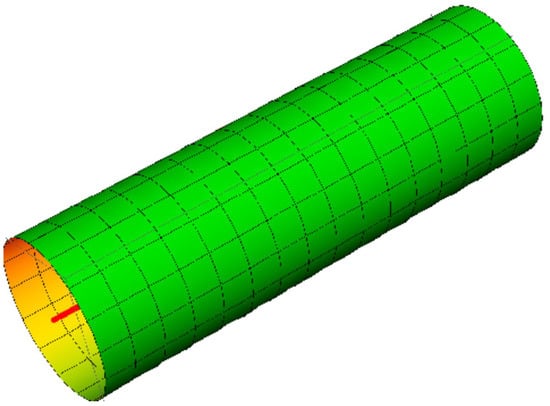
Figure 1.
M withits spine curve .
Example 2.
Given a helix
For this curve,
The CBF , , } is
Then,
In view of the Equation (19), the singular curve is (Figure 2):
If , the sweeping surface in the commutative (Abelian) group with the spine curve is given by
which has various singularities on the striction curve (blue), see Figure 3; , .
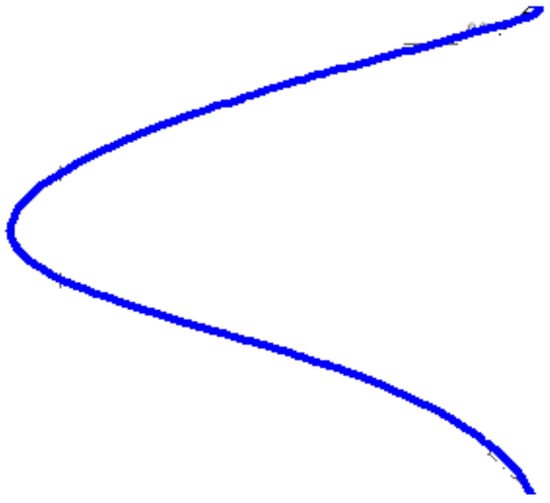
Figure 2.
has no singular points.
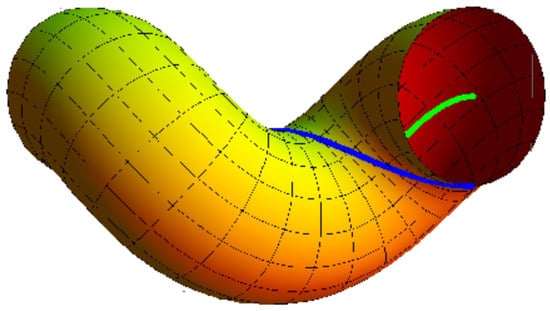
Figure 3.
M has singularities along .
3.2. Developable Surfaces
Developable surface can be simply realized as a special case of the ruled surface. The significance of the developable surface lies in the reality that it is utilized in many sectors of manufacturing and engineering, including modeling of apparel, automobile combinations, and ship hulls (see, e.g., [8,9,10,11]). Then, we check the case where the profile curve is turned into a line; that is, . Then, Equation (11) turns into
It is evident that d is a developable ruled surface; that is,
Via Proposition 2, all tangent vectors are parallel to . The rulings of d are curvature lines as well.
Proposition 4.
If the profile curve turns into a straight line, then the sweeping surface is a developable surface.
From Equation (11), we also have the following developable surface
Simply, we can show that (), ; that is, the surface d () interpolates the curve . Also, since
then, is the normal developable surface of d along . Thus, the surface d () interpolates the curve , and is a curvature line of d ().
Theorem 1.
Let M be the sweeping surface Equation (11). Then,
(1) the developable surfaces d and interrelated along at a right angle,
(2) the curve is a mutual curvature line of d and .
Theorem 2.
(Existence and uniqueness). Under the above notions, there exists a unique developable surface Equation (29).
Proof.
For the existence, we have the developable Equation (29). However, since d is a ruled surface, we may assume that
It can be seen that d is developable if and only if
However, as in Equation (31), we have:
where is a regular function. Further, the normal vector at the point is
Thus, from Equations (34) and (35), one finds that:
Thus, Equation (33) shows that , this is equivalent to , with . If is a regular point (i.e., ), then , and . This means that .
Now, if d has a singular point at , then , and . Let the singular point be in the closure of the set of points where d is developable along , which is regular, then there exists a point in any neighborhood of such that the uniqueness of d holds at . Passing to the limit is the uniqueness of the developable at . Suppose that J is an open interval such that d is singular at for any . Then, for any . This means that for . It obeys that
Thus, if and only if for any . In this case, . This means that uniqueness holds. □
As an implementation, such as flank milling or cylindrical milling, through the movement of the type-2 Bishop frame, we put a cylindrical cutter which is linked with this frame. Then, the equation of a group of cylindrical cutters, which is located by the movement of cylindrical cutter over , can be shown as follows:
where indicates the cylindrical cutter radius. The surface is an offset of the surface . The equation of , can then be written as
The vector normal is:
From Equation (38), we also have:
Thus, partial derivative can be gained as follows:
which shows the vector is orthogonal to . Additionally, the vector is orthogonal to the tool axis vector . As a result of this equation, the envelope surface of the cylindrical cutter and the developable surface have a mutual normal vector, and the distance between the two surfaces is equal to the radius of the cylindrical cutter, denoted by .
Proposition 5.
Let d be the developable surface Equation (29), and if being the envelope surface of the cylindrical cutter at distance ρ, then the two developable surfaces d and are offset developable surfaces.
We designate to represent 2), and by using Theorem 4.1 in [20], we can give the following:
Theorem 3.
Let d() be the developable surface Equations (29) and (30). Then,
(1) Surface d() is locally diffeomorphic to Cuspidal edge at if and only if , and .
(2) Surface d() is locally diffeomorphic to Swallowtail at iff , , and .
Example 3.
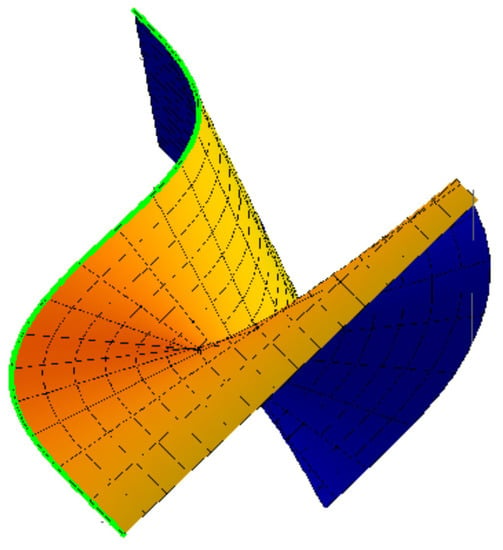
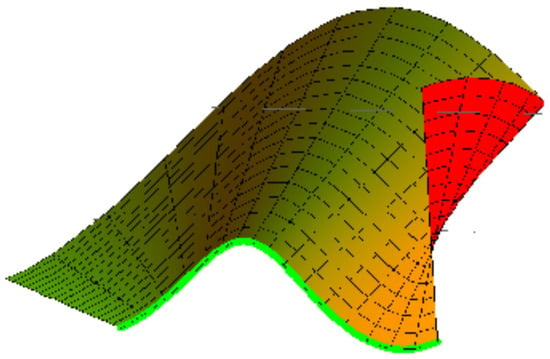
Based on Example 2, we have: (1) If , then , and . The developable surface
is locally diffeomorphic to Cuspidal edge, see Figure 4; , and

Figure 4.
Locally diffeomorphic to Cuspidal edge.
(2) If , then , , and . The developable surface
is locally diffeomorphic to Swallowtail, see Figure 5; , and .

Figure 5.
Locally diffeomorphic to Swallowtail.
Notice that the developable surfaces d and intersect along at , as can be seen in Figure 6.
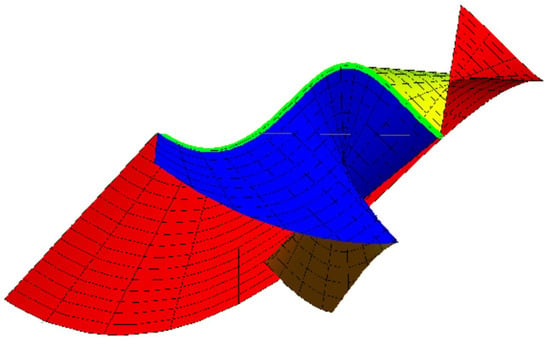
Figure 6.
.
4. Conclusions
A sweeping surface is a surface that is traced from a section curve positioned along a path, which acts as the spine curve, and it has symmetrical properties. In this study, we have parametrized sweeping surfaces with the conjugate mate curve of a spatial curve in the 3-dimensional Lie group . We showed that the parametric curves on these surfaces are curvature lines. Additionally, we derived sufficient and necessary conditions for this surface to be a developable ruled surface. In particular, we focused on the discussion of the singularities of this developable. Furthermore, we provide some representative examples.
There are several opportunities for further work. The authors plan to extend the study to different spaces and examine the classification of singularities as in [20,21,22,23,24,25,26,27,28].
Author Contributions
Conceptualization, A.A.-J. and R.A.-B.; methodology, A.A.-J. and R.A.-B.; investigation, A.A.-J. and R.A.-B.; writing—original draft preparation, A.A.-J. and R.A.-B.; writing—review and editing, A.A.-J. and R.A.-B. All authors have read and agreed to the published version of the manuscript.
Funding
This work was funded by the University of Jeddah, Jeddah, Saudi Arabia, under grant No. (UJ-21-DR-116). The authors, therefore, acknowledge with thanks the University of Jeddah technical and financial support.
Data Availability Statement
Our manuscript has no associated data.
Conflicts of Interest
The authors declare that there is no conflict of interest regarding the publication of this paper.
References
- Yoon, D.W.; Tuncer, Y.; Karacan, M.K. On curves of constant breadth in a 3-dimensional Lie group. Acta Math. Univ. Comen 2016, 85, 81–86. [Google Scholar]
- Yoon, D.W. Classifications of special curves in the Three-Dimensional Lie Group. Inter. J. Math. Anal. 2016, 11, 503–514. [Google Scholar]
- Okuyucu, O.Z.; Yıldız, O.G.; Tosun, M. Spinor Frenet equations in three dimensional Lie Groups. Adv. Appl. Clifford Algebr. 2016, 26, 1341–1348. [Google Scholar] [CrossRef]
- Yuzbası, Z.K.; Yoon, D.W. On constructions of surfaces using a geodesic in Lie group. J. Geom. 2019, 110, 1–10. [Google Scholar] [CrossRef]
- Cakmak, A. New type direction curves in 3-dimensional compact Lie group. Symmetry 2019, 11, 387. [Google Scholar] [CrossRef]
- Yoon, D.W.; Yüzbası, Z.K. A generalization for surfaces using a line of curvature in Lie group. Hacet. J. Math. Stat. 2001, 50, 444–452. [Google Scholar] [CrossRef]
- Nazra, S.H.; Abdel-Baky, R.A. Ruled surfaces with constant breadth in 3-dimensional Lie group. Asian-Eur. J. Math. 2022, 15, 2250205. [Google Scholar] [CrossRef]
- Nazra, S.H.; Abdel-Baky, R.A. Sweeping Surfaces in the 3-dimensional Lie Group. Symmetry 2022, 14, 698. [Google Scholar] [CrossRef]
- Carmo, M.P.D. Differential Geometry of Curves and Surfaces; Prentice Hall: Englewood Cliffs, NJ, USA, 1976. [Google Scholar]
- Pottmann, H.; Wallner, J. Computational Line Geometry; Springer: Berlin/Heidelberg, Germany, 2001. [Google Scholar]
- Klok, F. Two moving coordinate frames for sweeping along a 3D trajectory. Comput. Aided Geom. Des. 1986, 3, 217–229. [Google Scholar] [CrossRef]
- Wang, W.; Joe, B. Robust computation of the rotation minimizing frame for sweeping surface modelling. Comput.-Aided Des. 1997, 29, 379–391. [Google Scholar] [CrossRef]
- Farouki, R.T.; Sakkalis, T. A complete classification of quintic space curves with rational rotation-minimizing frames. J. Symb. Comput. 2012, 47, 214–226. [Google Scholar] [CrossRef]
- Abdel-Baky, R.A. Developable Surfaces through Sweeping Surfaces. Bull. Iran. Math. Soc. 2019, 45, 4951–4963. [Google Scholar] [CrossRef]
- Aumann, G. Interpolation with developable bezier patches. Comput. Aided Geom. Des. 1991, 8, 409–420. [Google Scholar] [CrossRef]
- Zhao, H.Y.; Wang, G.J. A new method for designing a developable surface utilizing the surface pencil through a given curve. Prog. Nat. Sci. 2008, 18, 105–110. [Google Scholar] [CrossRef]
- Li, C.Y.; Wang, R.H.; Zhu, C.G. Parametric representation of a surface pencil with a common line of curvature. Comput.-Aided Des. 2011, 43, 1110–1117. [Google Scholar] [CrossRef]
- Li, C.Y.; Wang, R.H.; Zhu, C.G. An approach for designing a developable surface through a given line of curvature. Comput.-Aided Des. 2013, 45, 621–627. [Google Scholar] [CrossRef]
- Althibany, N.M. Construction of developable surface with geodesic or line of curvature coordinates. J. New Theory 2021, 36, 75–87. [Google Scholar] [CrossRef]
- Sharief, D.; Bang, Y.C.; Azeb, A. Natural mates of Frenet curves in Euclidean 3-space. Turk. J. Math. 2018, 42, 2826–2840. [Google Scholar]
- Bekar, M.; Hathout, F.; Yusuf, Y. Singularities of rectifying developable surfaces of Legendre curves on UTS. Inter. J. Geom. 2022, 1, 20–33. [Google Scholar]
- Li, Y.; Tuncer, O.O. On (contra)pedals and (anti)orthotomics of frontals in de Sitter 2-space. Math. Meth. Appl. Sci. 2023, 1, 1–15. [Google Scholar] [CrossRef]
- Li, Y.; Erdoğdu, M.; Yavuz, A. Differential Geometric Approach of Betchow-Da Rios Soliton Equation. Hacet. J. Math. Stat. 2022, 1, 1–12. [Google Scholar] [CrossRef]
- Li, Y.; Abolarinwa, A.; Alkhaldi, A.; Ali, A. Some Inequalities of Hardy Type Related to Witten-Laplace Operator on Smooth Metric Measure Spaces. Mathematics 2022, 10, 4580. [Google Scholar] [CrossRef]
- Li, Y.; Aldossary, M.T.; Abdel-Baky, R.A. Spacelike Circular Surfaces in Minkowski 3-Space. Symmetry 2023, 15, 173. [Google Scholar] [CrossRef]
- Li, Y.; Chen, Z.; Nazra, S.H.; Abdel-Baky, R.A. Singularities for Timelike Developable Surfaces in Minkowski 3-Space. Symmetry 2023, 15, 277. [Google Scholar] [CrossRef]
- Li, Y.; Eren, K.; Ayvacı, K.H.; Ersoy, S. The developable surfaces with pointwise 1-type Gauss map of Frenet type framed base curves in Euclidean 3-space. AIMS Math. 2023, 8, 2226–2239. [Google Scholar] [CrossRef]
- Li, Y.; Abdel-Salam, A.A.; Saad, M.K. Primitivoids of curves in Minkowski plane. AIMS Math. 2023, 8, 2386–2406. [Google Scholar] [CrossRef]
Disclaimer/Publisher’s Note: The statements, opinions and data contained in all publications are solely those of the individual author(s) and contributor(s) and not of MDPI and/or the editor(s). MDPI and/or the editor(s) disclaim responsibility for any injury to people or property resulting from any ideas, methods, instructions or products referred to in the content. |
© 2023 by the authors. Licensee MDPI, Basel, Switzerland. This article is an open access article distributed under the terms and conditions of the Creative Commons Attribution (CC BY) license (https://creativecommons.org/licenses/by/4.0/).